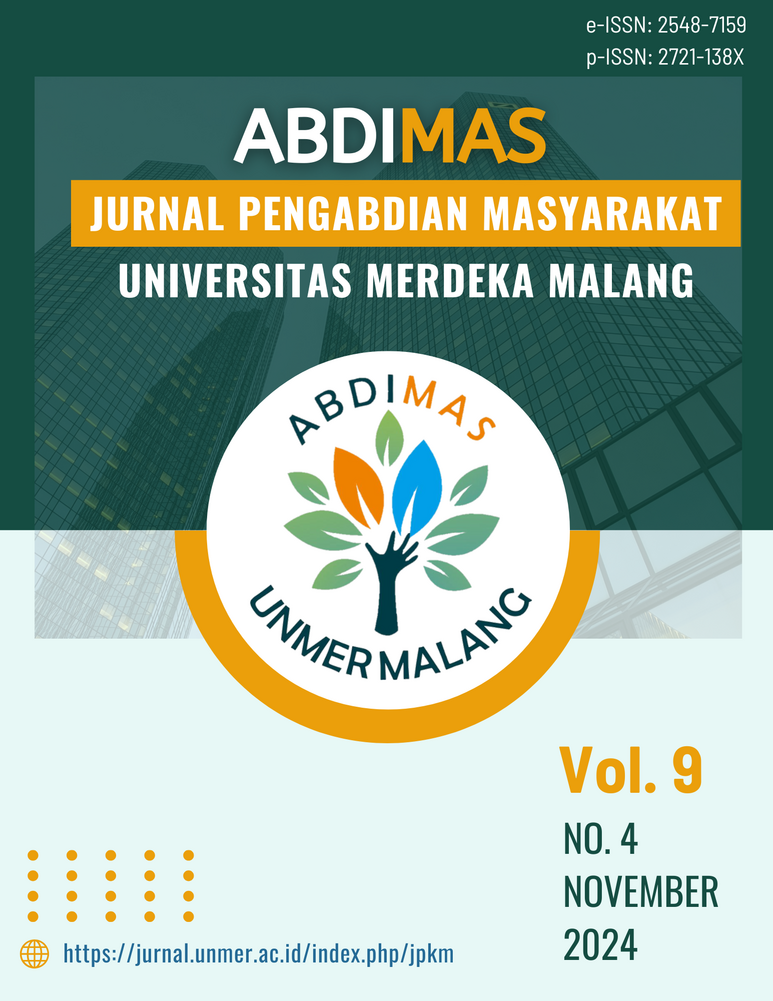Management of fruit and vegetable waste into ecoenzyme in Drien Rampak Village, West Aceh Regency
DOI:
https://doi.org/10.26905/abdimas.v9i4.13984Keywords:
Community empowerment, Ecoenzyme, Fruit peel residue, Organic waste, Waste managementAbstract
The accumulation of waste in public areas of Drien Rampak Village remains an unresolved issue. The growing population has led to increased consumption and waste production. Currently, there is no waste management mechanism capable of addressing this problem effectively. The waste is predominantly household waste, such as organic fruit and vegetable residues. This activity aimed to provide training to the PKK women’s group in Drien Rampak Village on making ecoenzymes as a solution for managing organic waste. The implementation included training and hands-on assistance. The stages of the activity were as follows: coordination with partners, education on waste management, ecoenzyme-making training, fermentation process, and ecoenzyme harvesting. The activity produced 100 liters of ecoenzyme using 30 kg of fruit and vegetable residues. Based on pre-test and post-test questionnaire results, significant improvements were observed in participants' attitudes, knowledge, and skills in managing household organic waste. The highest improvement was in attitudes (16.84-point difference), followed by skills (13.11-point difference) and knowledge (5.49-point difference).
Downloads
References
Agnafia, D. N., Rohmani, L. A., & Anfa, Q. (2022). Peningkatan pemahaman limbah organik rumah tangga dan cara pemanfaatannya melalui ecoenzyme. JMM (Jurnal Masyarakat Mandiri), 6(4), 2605-2614. https://doi.org/10.31764/jmm.v6i4.8867
Artiningrum, T. (2017). Potensi emisi metana (CH4) dari timbulan sampah kota Bandung. Geoplanart, 1(1), 36-44.
Badan Pusat Statistik Kabupaten Aceh Barat. (2022). Kecamatan Johan Pahlawan dalam Angka. Badan Pusat Statistik Kabupaten Aceh Barat.
Buckle, K., Edward, R., Fleet, G., & Wootton, M. (2009). Ilmu pangan. Jakarta: UI-Press.
Dondo, Y., Sondakh, T. D., & Nangoi, R. (2023). The effectiveness of using ecoenzymes based on several kinds of fruit on the growth of lettuce (Lactuca sativa L.). Jurnal Agroekoteknologi Terapan, 4(1), 147–158. https://doi.org/10.35791/jat.v4i1.46243
Fadilah, U., Wijaya, I. M. M., & Antara, N. S. (2018). Studi pengaruh pH awal media dan lama fermentasi pada proses produksi etanol dari hidrolisat tepung biji nangka dengan menggunakan Saccharomycess cerevisiae. Jurnal Rekayasa dan Manajemen Agroindustri, 6(2), 92-102. https://doi.org/10.24843/JRMA.2018.v06.i02.p01
Firmansyah, A. (2023, February 13). Produksi sampah kawasan perkotaan meulaboh capai 100 ton per hari. AJNN.net. Retrieved from: https://www.ajnn.net/news/produksi-sampah-kawasan-perkotaan-meulaboh-capai-100-ton-per-hari/index.html
Galintin, O., Rasit, N., & Hamzah, S. (2021). Production and characterization of eco enzyme produced from fruit and vegetable wastes and its influence on the aquaculture sludge. Biointerface Research in Applied Chemistry, 11(3), 10205-10214. https://doi.org/10.33263/BRIAC113.1020510214
Gaspersz, M. M., & Fitrihidajati, H. (2022). Pemanfaatan ekoenzim berbahan limbah kulit jeruk dan kulit nanas sebagai agen remediasi LAS detergen. LenteraBio: Berkala Ilmiah Biologi, 11(3), 503-513.
Gumilar, G. G., Kadarohman, A., & Nahadi, N. (2023). Ecoenzyme production, characteristics, and applications: A review. Jurnal Kartika Kimia, 6(1), 45-59. https://doi.org/10.26874/jkk.v6i1.186
Kementerian Lingkungan Hidup dan Kehutanan. (2018). Pedoman pengelolaan sampah skala rumah tangga. Kementerian Lingkungan Hidup dan Kehutanan.
Larasati, D., Astuti, A. P., & Maharani, E. T. W. (2020). Uji organoleptik produk eco-enzyme dari limbah kulit buah (studi kasus di Kota Semarang). In Seminar Nasional Edusaintek, FMIPA, UNIMUS.
Masjud, Y. I., Sidjabat, F. M., Rahmiati, F., & Amin, G. (2022). Training on making composter bins for household organic waste treatment. Abdimas: Jurnal Pengabdian Masyarakat Universitas Merdeka Malang, 7(1), 20-27. https://doi.org/10.26905/abdimas.v7i1.6057
Nangoi, R., Paputungan, R., Ogie, T. B., Kawulusan, R. I., Mamarimbing, R., & Paat, F. J. (2022). Utilization of household organic waste as an eco-enzyme for the growth and product of cultivate culture (Lactuca sativa L.). Jurnal Agroekoteknologi Terapan, 3(2), 422-428. https://doi.org/10.35791/jat.v3i2.44862
Nisa, M. A., Wati, N. L., Nur, A. A., Fitria, F., Apriani, K. N., & Fajrin, R. R. (2022). Training on waste management into a useful product in Bunipah Village, Banjar Regency. Abdimas: Jurnal Pengabdian Masyarakat Universitas Merdeka Malang, 7(1), 11-19. https://doi.org/10.26905/abdimas.v7i1.5791
Putri, S. A., Restuhadi, F. & Rahmayuni. (2016). Hubungan antara kadar gula reduksi, jumlah sel mikrob dan etanol dalam produksi bioetanol dari fermentasi air kelapa dengan penambahan urea. Journal Jom FAPERTA, 3(2), 1-8.
Rohmah, N. U., A. P. Astuti, and E. T. W. Maharani. (2020). Organoleptic test of the ecoenzyme pineapple honey with variations in water content. In Seminar Nasional Edusaintek, FMIPA, UNIMUS.
Saleem, M., & Saeed, M. T. (2020). Potential application of waste fruit peels (orange, yellow lemon and banana) as wide range natural antimicrobial agent. Journal of King Saud University-Science, 32(1), 805-810. https://doi.org/10.1016/j.jksus.2019.02.013
Septiani, U., Najmi, N., & Oktavia, R. (2021, October). Eco enzyme: Pengolahan sampah rumah tangga menjadi produk serbaguna di Yayasan Khazanah Kebajikan. In Prosiding Seminar Nasional Pengabdian Masyarakat LPPM UMJ.
Sharon, S. S., Suade, Y. K. M., & Tanesia, C. Y. (2023). Socialization of regional regulations regarding waste management to increase awareness of environmental cleanliness for MSMEs. Abdimas: Jurnal Pengabdian Masyarakat Universitas Merdeka Malang, 8(1), 188-198. https://doi.org/10.26905/abdimas.v1i1.8806
Varshini, B., & Gayathrif, V. (2023). Role of eco-enzymes in sustainable development. Nature Environment and Pollution Technology, 22(3), 1299-1310. https://doi.org/10.46488/NEPT.2023.v22i03.017
Yulistiar, F. W., & Manggalou, S. (2023). Inovasi eco-enzyme dalam mendukung pemerintah menuju net zero emission di Indonesia. Public Inspiration: Jurnal Administrasi Publik, 8(1), 50-60. https://doi.org/10.22225/pi.8.1.2023.50-60
Downloads
Published
How to Cite
Issue
Section
License
Copyright (c) 2024 Abdimas: Jurnal Pengabdian Masyarakat Universitas Merdeka Malang

This work is licensed under a Creative Commons Attribution-ShareAlike 4.0 International License.
Authors who publish with this journal agree to the following terms:
- Copyright of the published articles will be transferred to the journal as the publisher of the manuscripts. Therefore, the author confirms that the copyright has been managed by the journal.
- Publisher of Abdimas: Jurnal Pengabdian Masyarakat Universitas Merdeka Malang is University of Merdeka Malang.
- The copyright follows Creative Commons Attribution-ShareAlike License (CC BY SA): This license allows to share, copy, and redistribute the material in any medium or format, adapt, remix, transform, and build upon the material, for any purpose, even commercially.





